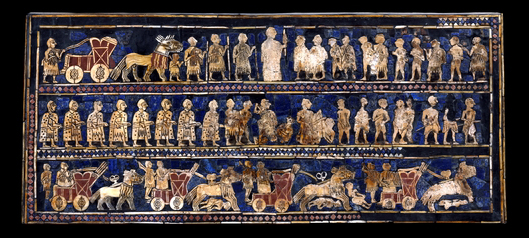The city of Ur
The main excavations at Ur were undertaken from 1922-34 by a joint expedition of The British Museum and the University Museum, Pennsylvania, led by Leonard Woolley. At the center of the settlement were mud brick temples dating back to the fourth millennium B.C.E. At the edge of the sacred area a cemetery grew up which included burials known today as the Royal Graves. An area of ordinary people’s houses was excavated in which a number of street corners have small shrines. But the largest surviving religious buildings, dedicated to the moon god Nanna, also include one of the best preserved ziggurats, and were founded in the period 2100-1800 B.C.E. For some of this time Ur was the capital of an empire stretching across southern Mesopotamia. Rulers of the later Kassite and Neo-Babylonian empires continued to build and rebuild at Ur. Changes in both the flow of the River Euphrates (now some ten miles to the east) and trade routes led to the eventual abandonment of the site.
The royal graves of Ur
The majority of graves had been robbed in antiquity but where evidence survived the main burial was surrounded by many human bodies. One grave had up to seventy-four such sacrificial victims. It is evident that elaborate ceremonies took place as the pits were filled in that included more human burials and offerings of food and objects. The excavator, Leonard Woolley thought the graves belonged to kings and queens. Another suggestion is that they belonged to the high priestesses of Ur.
The Standard of Ur
The main panels are known as “War” and “Peace.” “War” shows one of the earliest representations of a Sumerian army. Chariots, each pulled by four donkeys, trample enemies; infantry with cloaks carry spears; enemy soldiers are killed with axes, others are paraded naked and presented to the king who holds a spear.
Queen’s Lyre
The wooden parts of the lyre had decayed in the soil, but Woolley poured plaster of Paris into the depression left by the vanished wood and so preserved the decoration in place. The front panels are made of lapis lazuli, shell and red limestone originally set in bitumen. The gold mask of the bull decorating the front of the sounding box had been crushed and had to be restored. While the horns are modern, the beard, hair and eyes are original and made of lapis lazuli.
Candela Citations
- The Standard of Ur and other Objects from the Royal Graves at Ur. Authored by: British Museum. Provided by: British Museum. Located at: https://www.khanacademy.org/humanities/ap-art-history/ancient-mediterranean-ap/ancient-near-east-a/a/standard-of-ur-and-other-objects-from-the-royal-graves. License: CC BY-NC-SA: Attribution-NonCommercial-ShareAlike






